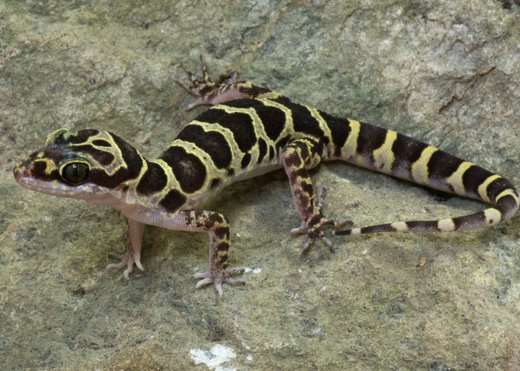A team of scientists discovered 15 new species of gecko in Myanmar during a two-week period this month. The gecko species are all adapted to living in limestone karsts in eastern and southern Myanmar, highlighting the biodiversity of these ecosystems.
Many species that live in karst landscapes, which are characterized by limestone towers and caves, are found nowhere else in the world. Some are found only on a single limestone block.
“Although we already knew that some less mobile cave species such as snails and fish were restricted to just one cave or limestone hill, we now know that the same applies to some geckos,” said Dr. Tony Whitten, a senior adviser to Fauna and Flora International (FFI), which supported the research that led to the discoveries.
The newly discovered species include bent-toed gecko species and three dwarf gecko species.
The discoveries will the subject of three scientific journal articles that will come out over the next three weeks. One article will cover each species, and the third article will cover other gecko species that were discovered in Myanmar earlier this year.
The papers will frame the discoveries as examples of “high-localized diversity and unprecedented micro-endemism.”
The papers are to be authored by Dr. L. Lee Grismer of La Sierra University in California, who also led the team of researchers who made the discoveries. He said the importance of the discoveries is magnified by the fact that the species live in an endangered microhabitat that has frequently been cut off from the world by civil conflict in a country without a robust conservation sector. Some of the species were found in rebel-held territory, making conservation even more challenging.
The team also included karst conservationists from FFI’s Myanmar team, scientists from the Universiti Sains Malaysia and Brigham Young University, and researchers from Myanmar’s Forestry Department.
A special gecko name
Whereas 14 of the new species were named after the places where they were discovered, one species – Hemiphyllodactylus tonywhitteni – was named after FFI’s Dr. Tony Whitten, who has been a vocal advocate for karst conservation. H. tonywhitteni has only been observed in one cave in the Taunggyi District.
According to the article that covers the gecko, this naming choice “honors Dr. Tony Whitten, who has championed a broad range of conservation efforts in Indonesia and Asia-Pacific for well over a quarter of a century. His tireless efforts to conserve and help manage karst ecosystems have been a great inspiration to the senior author [Dr. Grismer].”
It also reflects the author’s call for more field work and conservation efforts in Southeast Asian microhabitats. Karst habitats in particular face the threat of quarrying by the cement industry.
“Hundreds of new species could face extinction without proper management,”Dr. Grismer said. “But this [management] cannot happen unless these species are discovered and described – hence why we are ramping up our efforts in these regions.”




